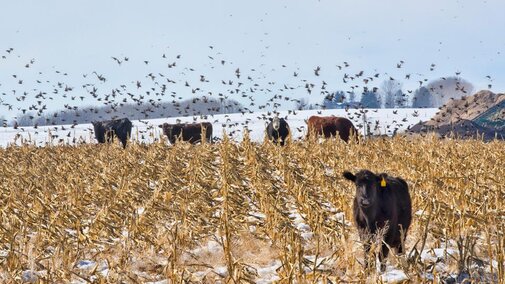Mid-winter Cornstalk Grazing
Here in mid-winter, cornstalks remain a great forage resource for livestock producers. So far, snow cover on cornstalks has been minimal, or what snow has fallen has mostly melted off. While cattle can graze with snow cover, remember that if an icy crust develops on the snow, this will limit grazing and supplemental feed may need to be provided.
Another important consideration is the stocking rate and how long they have been in a particular field. Nutritional value of cornstalk residue is greatest at the beginning of a grazing period and declines with time as the most nutritious plant parts are consumed. A general stalk grazing rule is there is about 30 cow days per 100 bushels of corn that the field produced.
Over the fall and winter, weathering can also play a role in reducing cornstalk quality. Rain or melting snow soaks into dry cornstalk residue and leaches out some of the soluble nutrients. Most serious is the loss of sugars and other energy-dense nutrients, which lowers the TDN or energy value of the stalks.
Another factor that affects cornstalk grazing is wind. We have had our share of excessively high winds, which easily blow corn leaves and husks off the field. This, of course, can impact the amount of feed, and after grain, those leaves and husks contain the highest nutritional quality.
Cornstalks are still a great and economical winter feed source. Just be sure to closely monitor cow and field conditions while adjusting your supplementation program accordingly.
Using Bad Hay and Silage
Low supply and high costs mean some less-than-ideal feedstuffs may be used this winter. Low quality, mold and even mycotoxins can all be a risk for poor quality feeds. Can we still make use of these forage options?
Silage put up too wet has likely had a clostridial fermentation resulting in poor quality and high levels of butyric acid. Not only is feed quality reduced, but the stability of the pile once opened drops as well and mold growth on the feeding face is more likely.
In both hay and silage stored too dry, mold growth is a primary concern. Mold reduces feed quality and can limit intake in high quantities. In some circumstances, molds can produce mycotoxins, even with low mold counts. Impacts of mycotoxins are wide-ranging and depend on the specific toxin or toxins present and concentrations. Impacts can range from reduced intake to liver and rumen damage to infertility and abortions.
Whether too wet or too dry, these feed options are less than ideal but can still be used if we take precautions. First, test. Knowing the levels of mold, butyric acid or mycotoxin in a feed can help with the next step — dilution. Keeping poor feed to a low percentage of the overall diet can allow for use while minimizing risk to livestock. Finally, don’t feed to high-risk animals. Young calves, stressed animals and those in late gestation are all at higher risk of impact.
Low quality silage and hay comes with risks. Knowing the impact mold, mycotoxins and butyric acid can have on quality, intake and animal health is important and can help us plan the best way to use these imperfect feed resources.

